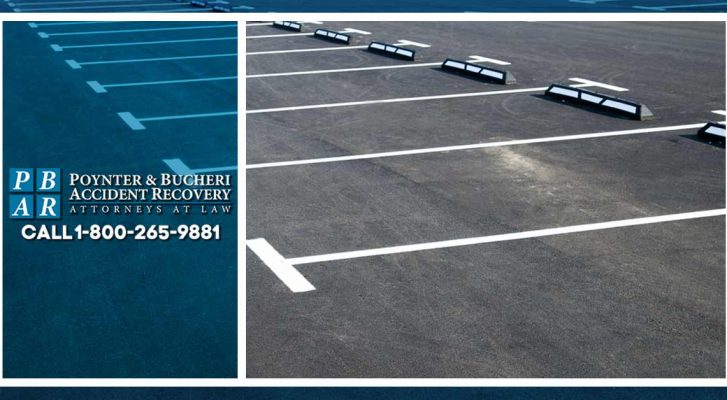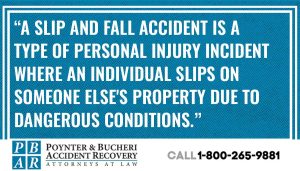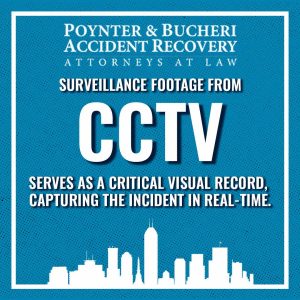
I Slipped and Fell on Parking Lot Oil. Can I Sue?

What you’ll learn reading this article about parking lot slip and fall injuries and accidents:
- What a slip and fall accident is and where they most often occur.
- Who is liable for slip and fall accident injuries in parking lots.
- What compensation a person might be due for injuries sustained in a slip and fall accident.
- Typical reasons why parking lot slip and fall accidents happen.
- How an attorney can help you navigate the long and complicated process of seeking compensation from responsible parties in a parking lot slip and fall accident.
What Is a Parking Lot Slip and Fall Accident?

A slip and fall accident is a type of personal injury incident where an individual slips on someone else’s property due to dangerous conditions. These slip-and-fall accidents commonly occur in retail stores, supermarkets, restaurants, public spaces, or private properties.
The potential causes of slip and fall accidents are diverse and can include wet or slippery floors, uneven surfaces, inadequate lighting, obstacles in walkways, or poorly maintained premises.
Is a business the responsible party liable for injuries that occur when a customer slips and falls on snow or ice around the business or in their poorly maintained parking lot?
One place most Americans visit weekly, often multiple times, is parking lots, a spot ripe for slip and fall injuries and accidents that range from bruises, to broken bones, to fatal head and spine injuries.
Identifying Potential Parking Lot Hazards Leading to Slip and Fall Cases
Parking lot owners are liable for recognizing and addressing hazards that could result in a foreseeable parking lot accident on their premises. Many people are at a business when they slip and fell. Parking lot oil can be a cause or even a pothole. To determine negligence when fall accidents happen, it’s important to examine the accident location to determine the actual and/or proximate cause.
In the context of a parking lot, slip and fall risks may include:
Spills of oil or other slippery liquids like oil: Such spills of slick substances like oil or other motor fluids pose an immediate risk of slipping in a parking lot, emphasizing the need for prompt cleanup measures to prevent accidents and falls. Owners should implement regular inspections to detect oil spills and address these hazards promptly.
Insufficient lighting leading to limited visibility: Inadequate lighting in a parking lot increases the likelihood of accidents, making adequate illumination crucial. Improved visibility enhances safety and helps identify and mitigate other potential dangers.
Absence of handrails in necessary areas: Handrails are vital in providing stability and support, particularly in areas of the parking lot where elevation changes occur. Owners should conduct assessments to identify locations requiring handrails, ensuring the overall safety of people walking in the area.
Hazardous conditions like potholes, cracked pavement, uneven surfaces, or damaged pavement: Regular maintenance and timely repairs prevent accidents as a direct result of tripping or stumbling. Owners should establish routine inspections to identify and rectify compromised pavement conditions.
Accumulation of standing water due to inadequate drainage systems: Proper drainage systems are imperative to prevent water accumulation, reducing the risk of slip and fall incidents. Owners should invest in efficient drainage solutions to mitigate the potential hazards associated with standing water.
Presence of garbage, debris, or other obstacles obstructing walking areas: Clear pathways through the parking lot offer safe pedestrian movement, requiring property owners to implement regular cleanup efforts. Establishing a proactive approach to debris removal ensures a clutter-free environment, minimizing a leading cause of accidents.
Lack of warning signs indicating potential hazards: Warning signs are crucial communication tools to alert pedestrians to potential dangers. Responsible property owners should strategically place signs in areas with known hazards, fostering awareness and preventing unsuspecting slip and fall incidents.
Wheel stops: When not properly maintained, wheel or curb stops become loose and increase the risk of parking lot slip and fall accidents. Weather and vehicular damage can cause the concrete to deteriorate over time, exposing rebar pins. These damaged concrete blocks can create fall hazards for pedestrians.
Damaged pavement: Snow, ice, road salt, and time can erode concrete and asphalt paving of parking lots. Harsh weather creates uneven patches, cracks, and potholes. Unsuspecting pedestrians can easily slip and fall because of improperly kept pavement in a parking lot that property owners didn’t maintain.
Wet and icy surfaces: Ice and water can be dangerous for walkers. Parking lots, in particular, have the potential for black ice, which blends in and is not seen easily by pedestrians and drivers. Parking lot slip and fall accidents are more common when standing water, oil slicks or a motor oil spill, and flooding due to heavy rainfall.
Obstructions and debris: Parking lot accidents can also be due to litter and debris. Shopping carts and other items may be left haphazardly in parking lots. The store should make sure employees work to clean and remove any obstacles and items that are not meant to be in the parking lot.
If you fell and suffered an injury attributed to a weather-related hazard, your attorney will thoroughly evaluate the circumstances. Our experienced personal injury attorney’s goal is proving negligence by the property owner played a significant role in getting you the compensation you deserve.
Is The Parking Lot Property Owner Liable for Injuries Caused by Potholes?
Hoosiers are all too familiar with potholes, and while they are problematic for drivers, they can be even worse for pedestrians. Every property owner has a duty to their customers, tenants, and visitors to maintain their public property well, including the parking lot.
If a pothole is present for an extended time without the construction company, property owner, or manager taking reasonable steps to repair the situation. If you are injured and can prove the property owner knew about the dangerous circumstances that caused the accident or circumstances surrounding it, they can be held liable for serious injuries.
A personal injury lawyer ensures you hold the property owners liable for damages from your medical bills, lost wages, and pain and suffering. Contact Poynter & Bucheri at 800-265-9881 for a free evaluation of your parking lot slip and fall case!
What if the Property Owner Is Only Partially Responsible for the Injuries?
In parking lot slips and falls, the legal principle of comparative negligence becomes crucial in determining liability and apportioning responsibility between the parties involved. Comparative negligence acknowledges that the property owner bears partial responsibility for the accident and can be held liable for some damages related to a minor or more serious injury.
If the injured party is found to have contributed to their injuries by not exercising due care or ignoring warning signs, their level of negligence is assessed.
The court then assigns a percentage of fault to the injured and the other party based on their respective contributions to the incident. In this situation, the compensation awarded to the injured party is reduced proportionally to their determined level of fault.
This legal framework ensures a fair and equitable distribution of responsibility, recognizing that accidents often result from a combination of factors.
Parking lot slips and falls may involve considerations such as the victim’s awareness of hazards, the property owner’s maintenance practices, and the presence of warning signs.
A thorough examination of the circumstances is essential to determine the extent of comparative negligence and establish a just outcome in terms of compensation.
Steps to Take After a Slip and Fall Accident on Someone Else’s Property
First, seek medical attention for yourself or the loved one who suffered a slip and fall injury or fell in a parking lot accident.
If possible, gather evidence of the circumstances surrounding your parking lot slip and fall accident and injury, using reasonable steps such as taking photographs of the accident scene and your fall injury, medical records, medical bills, and witness contact information.

Once you’re safe, contacting an attorney well-versed in slip-and-fall accidents can be an important step in making a slip-and-fall case.
Many public parking lots now feature surveillance and security cameras. While the property owner of a store or business may be reluctant to provide you footage that could paint them or another party as liable for serious injury, a fall attorney can apply legal pressure on the property owner to obtain any video evidence.
Your personal injury lawyer will also be able to help you file your claim before the statute of limitations expires for your parking lot slip and fall accident case. In Indiana, this limit depends on the type of property on which your slip and fall accident occurred.
How To Prove Fault in Parking Lot Slip and Fall Accidents
An attorney specializing in premises liability must thoroughly examine specific aspects of your slip and fall case. These inquiries encompass determining the party responsible for the accident, understanding how the liable party’s actions contributed to the incident, and assessing the potential contribution of the victim’s actions. The responses to these queries play a pivotal role in shaping the direction of the case and identifying available compensation for the victim injured in a parking lot.
In addressing a parking lot slip and fall case, it is essential to establish negligence and demonstrate that this negligence directly resulted in the injury and subsequent damages.
Supporting Evidence for the Impact of a Slip and Fall Accident May Involve:
Surveillance footage from security cameras: This footage serves as a critical visual record, capturing the incident in real-time and providing an invaluable perspective for assessing liability. It offers a nuanced understanding of the circumstances surrounding the accident.
A visual documentation through photographs: Photographs document the physical conditions at the time of the incident and serve as compelling visual evidence. They offer a tangible representation of the environment, contributing to a comprehensive portrayal of the accident scene.
Firsthand accounts provided by eyewitnesses: Eyewitness testimonies are essential in corroborating events and adding credibility to the case. The personal narratives of those who witnessed the incident firsthand offer unique insights into the dynamics of the accident.
Any filed police report documenting the incident: A filed police report provides an official incident record, offering an objective and documented account. It is a foundational legal document outlining key details that can substantiate the slip-and-fall circumstances.
A detailed journal or written account chronicling the accident and injuries: A comprehensive written account becomes a personal narrative, capturing the incident’s immediate aftermath. This journal is a valuable tool for conveying the emotional and physical impact of the accident on the victim.
Documentation suggesting a history of similar incidents in the parking lot: Records indicating a history of similar incidents underscore patterns and potential negligence. This documentation can strengthen the argument for premises liability, highlighting the property owner’s awareness or neglect of recurring hazards.
Records illustrating when and how the property was maintained: Maintenance records provide insights into the property’s upkeep and can reveal any lapses that may have contributed to the slip and fall. Understanding the maintenance history is crucial for establishing accountability.
Medical records from the treating hospital and physician: Medical records offer a professional assessment of the injuries sustained, providing a comprehensive view of the victim’s health status post-accident. They serve as crucial evidence in determining the extent of medical care required.
Medical bills reflecting the cost of treatment, therapy, and rehabilitation: These bills not only quantify the financial impact of the injury but also establish the necessity and extent of medical interventions. They are tangible evidence of the economic consequences of the slip and fall.
Documents showing loss of wages or income: Documentation of lost wages or income establishes the economic repercussions of the incident. It demonstrates the tangible financial hardships endured by the victim due to the slip and fall.
Receipts for out-of-pocket expenses related to the injury, such as transportation or childcare: These receipts offer a detailed account of additional costs incurred due to the injury. They contribute to a comprehensive understanding of the financial burden when an accident occurs.
Additional evidence demonstrating noneconomic damages like pain and suffering or emotional anguish: Supporting evidence for noneconomic damages can include psychological evaluations, therapy records, or personal statements. This evidence provides a holistic view of the emotional toll and suffering experienced by the victim due to the slip and fall.
The compensation for a slip and fall accident is contingent upon the strength of the evidence presenting the injuries and damage sustained. Engaging an attorney willing to invest the time and effort to comprehend how the accident has impacted your life is imperative.
A lawyer will identify negligence, detail the damages incurred, prove liability and the need for compensation, and hold the responsible party liable.
Poynter & Bucheri – Indianapolis Slip and Fall Attorneys
If you, or a loved one falls and is suffering an injury due to someone else’s negligence, you need to know your legal rights to recover compensation from the law. Our personal injury attorneys are experienced with parking lot slip and fall injury and negligence cases like yours and can evaluate serious injuries and determine what compensation your case may be worth.
Let us leverage our extensive experience enforcing premises liability law and holding the at-fault party responsible for ensuring your injuries, to help win your case. Your legal rights are protected and help you seek compensation for your injuries and losses.
We fight to hold the person responsible and win your case, or you pay no attorney fees. Don’t hesitate—one of our experienced fall attorneys can immediately assist you. Contact Poynter & Bucheri today at 800-265-9881 for a free consultation.
